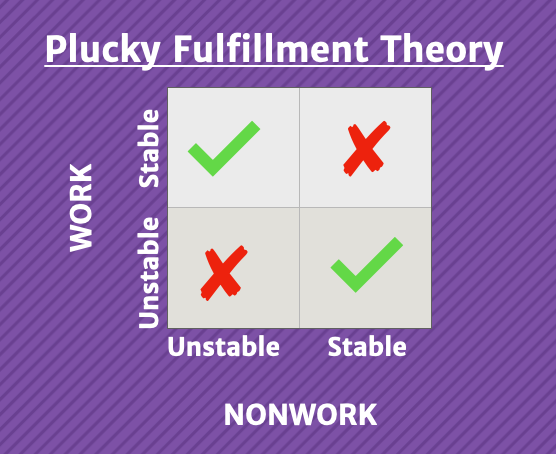I have a theory about healthy, fulfilled, working adults. I use this often in coaching, particularly when someone is struggling to figure out the current purpose of work in their lives.
Imagine your life split in two halves: work and non-work. Generally, non-work refers to home but it includes other projects, volunteering, family, your health, hobbies, etc. Generally, work refers to your 9-5 job.
For healthy, fulfilled adults, I have found that ONE of those halves is stable and ONE of them is unstable. By unstable, I don’t mean dangerous (though it could be). By ‘unstable,’ I mean that it changes, there are risks and things are able to shift.
Let’s imagine that non-work is stable.
You aren’t moving to a new home, the core folks in your life are stable, your health is stable, you have routine. If non-work is stable, you show up to work looking for instability. You arrive to work with some pep in your step, you’re more curious about R&D or new projects or ambitious assignments. You’re more bendable, more hungry to handle risk. In this case, instability at work is interesting and fulfilling to you.
Now let’s imagine that non-work is unstable.
You just had a baby or you’re going through a divorce or you’re moving or you’re working through health issues or there are weather events like wildfires or hurricanes approaching your city. If non-work is unstable, you show up to work looking for stability. You arrive at work looking for explicit instructions, ‘show me where my desk is and I’ll get to work,’ vibes. You aren’t inclined to raise your hand for new opportunities, you are looking for quiet, deep, known work. In this case, you’re not mailing it in — stability at work is not boring. In this case, stability is necessary for balance.
What happens if they’re both the same?
Let’s imagine that work and non-work are both unstable.
Things are changing at home, perhaps you’re caring for an ill family member, your partner has a new job and routines are upended. At the same time, you’re going through a re-org at work, rebuilding relationships with new teammates and wading through your first remote job. In this case, you burn out. Too much instability with no stability means that you’re living on quicksand. Bad times.
Now let’s imagine that work and non-work are both stable.
Your home routines are unchanging. The people in your life are stable and unchanging. You’ve had the same job for a while and even the hiccups seem to be cyclical. There are no X-factors. In this case, you have a mid-life crisis. If nothing is changing, you’re going to make something change — consciously or subconsciously.
Interestingly, a global pandemic did not have the same results on everyone. At face value, it seemed that Covid brought massive instability to non-work lives. Kids were home from school, all events were canceled, there were health risks everywhere you turned.
On the other hand, the lifestyle that’s been possible during Covid ended up being weirdly stable. No travel, no social events, same routines with the same trusted take-out or pod/bubble groups.
FWIW, I think this explains the massive amounts of attrition these days. Though Covid meant folks were generally looking for stability at work in 2020, in 2021 they’re over it. With lack of control to change things on a global scale, folks are resorting to changing what is in arms’ reach: their jobs.

How do you wield this theory for yourself?
Ok so first, be smart. If you’re in a season of great change at work, don’t throw yourself into a bidding war for a new house while changing schools for your kid while adopting a couple of puppies. Be mindful about your choices because they are all entwined.
Check in with yourself every few months or, at a minimum, when a new opportunity presents itself at or outside of work. Genuinely ask: what do I need from work these days? What do I not need? Then move forward accordingly.
How does this change the way you manage?
Realize that folks are working for different reasons. The same career ladders (and the pace with which employees want to move through them) will not work for everyone. It would be helpful to understand what each member of your team wants from work. Is it stability? Instability? There’s a lot of good manager work to do here as you earn this helpful blueprint for each of your reports.
But secondly, know your own answers. Unbalanced leaders threaten healthy teams with their power. If what you really need is a divorce, don’t sell the company to scratch that itch. Part of being a grown-up leader is being self-aware enough to solve the right problems with the right kinds of solutions.
In such wild times, I hope this is a simple framing helps you find your way forward. Hang in there; you have more control of your life’s fulfillment than you think.